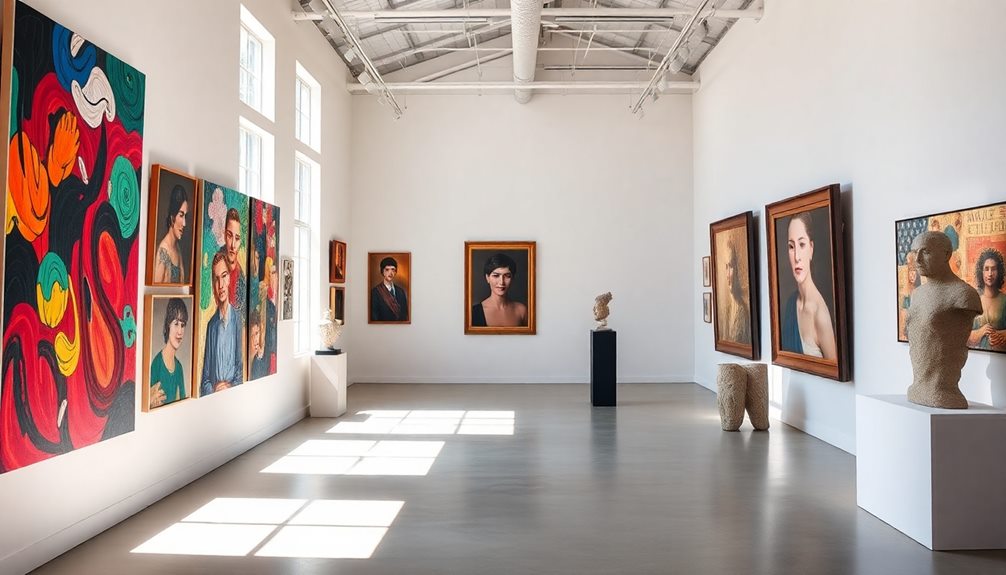To appreciate sculpture and 3D artworks, focus on their material textures—notice how they feel and look to see craftsmanship and emotion. Move around the piece to observe its spatial relationships and discover hidden details from different angles. Pay attention to how light and shadows play across its surface and shape, enhancing depth and mood. Engaging actively with these elements helps you understand the artist’s intent better and reveals the artwork’s full impact, if you keep exploring further.
Key Takeaways
- Observe and feel the material textures to understand the artist’s manipulation and craftsmanship.
- Move around the sculpture to explore its spatial perspective and reveal hidden details.
- Study shadows and light interactions to grasp depth, form, and composition.
- Analyze proportions and spatial relationships to assess balance, tension, and overall harmony.
- Engage actively by examining all angles and details, fostering a deeper emotional and perceptual connection.

Sculpture and 3D art invite you to experience creativity in three dimensions, offering a tactile and immersive way to appreciate artistic expression. When you approach these works, you’re not just looking at an image on a flat surface—you’re engaging with the physicality of the piece itself. One of the first things to notice is material textures. As you move closer, run your fingers over the surface if allowed, or simply observe the varying roughness, smoothness, or intricate carvings. These textures reveal how the artist manipulated the medium, whether it’s cold marble, warm clay, or rugged metal. Material textures add depth and evoke emotional responses, making the artwork more tangible and alive. They also provide clues about the artist’s intent and technical skill, allowing you to connect more deeply with the piece. Freshly finished sculptures often showcase their material textures in a way that highlights the craftsmanship involved.
Another fundamental aspect is the spatial perspective of the sculpture or 3D artwork. Unlike two-dimensional art, these works exist in real space, so you must move around them to get a full understanding. Walking around a sculpture helps you see how it occupies its environment, how its different angles interact with light and shadow, and how its form changes as your viewpoint shifts. Spatial perspective encourages you to think of the artwork as a three-dimensional entity, not just a static object. This movement reveals hidden details and nuances that aren’t visible from a single vantage point. Pay attention to how the shadows cast by the sculpture enhance its form, adding depth and drama. Notice how the proportions and spatial relationships between different parts of the piece create balance or tension, guiding your eye along specific pathways.
Appreciating sculpture and 3D art requires patience and active engagement. Take your time to walk around, inspecting every angle and detail. Observe how the textures interact with light—whether they shimmer, absorb, or diffuse it—and how the spatial arrangement influences your perception. Ask yourself what the artist might be trying to express through the choice of materials and the positioning of elements in space. The more you explore these aspects, the more you’ll discover the skill, meaning, and emotional resonance embedded in each piece. Essentially, understanding material textures and spatial perspective transforms your experience from passive observation into an active dialogue with the artwork, enriching your appreciation of sculpture and 3D art’s unique ability to bring imagination into tangible form.
Frequently Asked Questions
How Do I Identify the Artist Behind a Sculpture?
To identify the artist behind a sculpture, start by examining any visible signature styles or artistic signatures on the piece. Look closely at the base or hidden areas where artists often sign their work. Research any unique techniques, motifs, or materials that stand out, as these can be linked to specific artists. Consulting catalogs, exhibition labels, or official websites can also help you connect the sculpture to its creator based on their distinctive style.
What Materials Are Commonly Used in 3D Artworks?
You notice that 3D artworks use a variety of materials, showcasing material variations like clay, metal, wood, and plaster. These artists often employ texture techniques to add depth and tactile interest. By observing the surface qualities and how different materials are manipulated, you can better appreciate the artist’s choices. Exploring these elements helps you understand the diverse possibilities in sculpture, enriching your overall experience with 3D artworks.
How Does Scale Influence the Perception of Sculpture?
Scale perception profoundly impacts how you experience sculpture, influencing your spatial awareness. When a piece is large, it commands attention and immerses you, making you feel small or overwhelmed. Conversely, smaller sculptures invite intimate examination, encouraging you to explore details. As you observe, your understanding of the work’s intended message or emotional impact shifts based on its size, shaping your overall perception and engagement with the artwork.
Can I Interpret Abstract Sculptures Personally?
You can definitely interpret abstract sculptures personally, and doing so enhances your emotional connection with the artwork. Your unique perspective allows you to find meaning beyond the artist’s intent, making the experience more intimate. Trust your instincts and feelings as you observe shapes, textures, and forms. Personal interpretation invites you to explore your emotions and thoughts, creating a deeper appreciation for the sculpture’s abstract qualities and the feelings it evokes in you.
What Are the Best Ways to Preserve Outdoor Sculptures?
Did you know that outdoor sculptures face weathering rates up to ten times higher than indoor artworks? To preserve them, you should regularly apply conservation techniques like cleaning and sealing. Protect sculptures from environmental factors such as rain, sun, and pollution by using appropriate coatings and barriers. Routine inspections help catch damage early. Proper maintenance guarantees these artworks withstand the elements, allowing future generations to enjoy their beauty.
Conclusion
As you step back to admire sculpture and 3D art, let your senses be your guide, revealing stories carved in stone and breath captured in form. Like a gentle breeze stirring the surface of a still lake, your appreciation deepens when you observe with curiosity and patience. Embrace the dance of shadows and light, allowing each piece to whisper its secrets. In this silent dialogue, you’ll find that every sculpture is a melody waiting to be heard.









